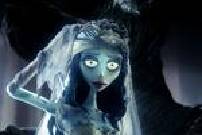|
|
||||
|
|
by Jeffrey Chen  Just as I was starting to get complacent with the state of animation, along comes Corpse Bride to show me there's yet more magic to be made with the old art form of creating movement one frame at a time. It's a reminder that this is a medium of limitless imagination, one that gains potency the further it steps away from reality. Better yet, as an exercise in stop-motion, it's a rebuke to the current 3-D computer animated takeover of the field. And what a beautiful rebuke it is. Corpse Bride is a progressive step on the path begun by The Nightmare Before Christmas in 1993. The creative vision behind both projects is attributed mostly to Tim Burton, who dreamed up the first and co-directed the second alongside Mike Johnson. Both movies bear the trademarks of Burton's style and carry common elements (particularly character design and an obsession with the macabre). When Nightmare came out it was a delightful surprise, a standout film that broke all kinds of preconceptions about the animated feature. That Corpse Bride can achieve almost exactly the same effect says something about how little the animation field has explored outside its comfort zone over the last 12 years. Corpse Bride, therefore, has its own set of animated peers to stand out from, and it couldn't have come at a better time. As studios close their traditional hand-drawn animation departments, we'll need more movies like this, like Sylvain Chomet's The Triplets of Belleville, like the Nick Park films Chicken Run and the upcoming Wallace & Gromit: The Curse of the Were-Rabbit. We'll need works with Corpse Bride's meticulously crafted quality, where the very look of the characters and the world they inhabit burst with uniqueness. They remain true to a vision and expression, to a conveyance of feeling, and not to kid-friendly humor with pop culture references for the adults. If one hunts for weaknesses, the most significant of Corpse Bride's may come from its comparison to Nightmare, if only because the two movies are so similar and, in that sense, the new movie isn't really all too new. But it gains strength if one sees it as an improvement of technique. The movement and effects in the new movie are dazzling; its a perfecting of a style, like a rock band finding its groove a few years after its first album. Also, this time the character designers get to have a lot more fun with human figures (there weren't that many in Nightmare), and the results look as if they popped right out of a caricaturist's sketchbook. Much of this indulgence in deformed-human design, along with its contrast to the design of the skeletal inhabitants of the afterlife, are what give the movie its confident flair as well as its visual thesis -- here, the dead and their colorful world are much more alive than the cold, blue-greytone world of the living, populated as it is with the selfish and greedy. Selflessness, as it turns out, emerges as the main theme -- the idea that there is nobility in sacrifice. Small wonder, then, that the dead are the good here. An appropriate parallel can indeed be drawn to the state of animation, for where does non-computer-generated animation dwell these days but in its death throes? In Corpse Bride, the freaks and the outsiders have more fun, but a heavy price is likely to be paid. For the movie itself, it's the huge amount of time spent in developing the work in a field that doesn't allow for much non-conformity. Still, being able to animate a plasticine dead bride and make her earn our sympathy as well as even make us weep for her fate is well worth that extra time and effort. (Released by Warner Bros. and rated "PG" for some scary images and action and brief mild language.) Review also posted at www.windowtothemovies.com. |
||
|
© 2025 - ReelTalk Movie Reviews Website designed by Dot Pitch Studios, LLC |



